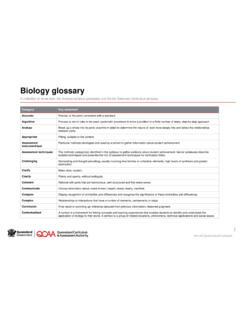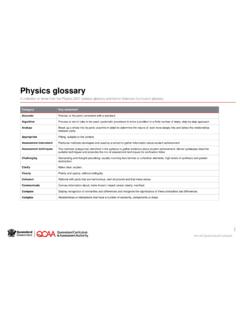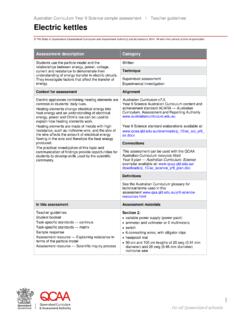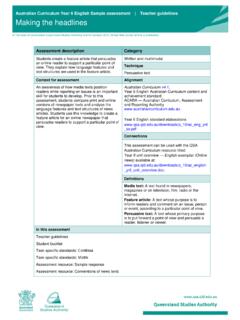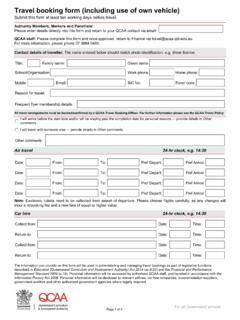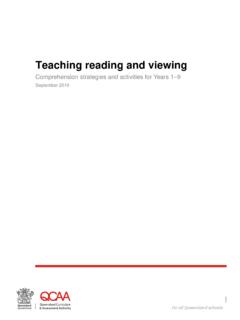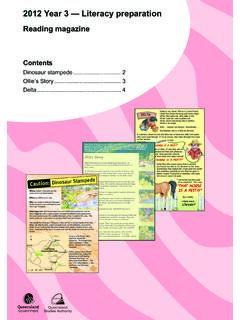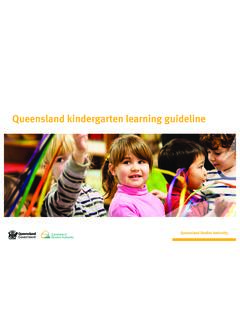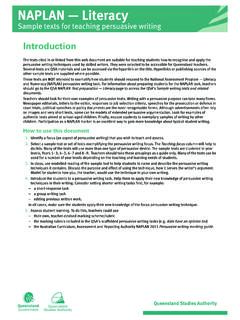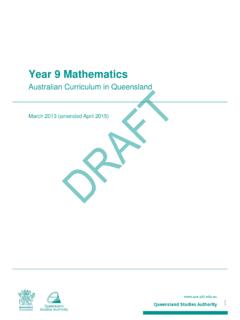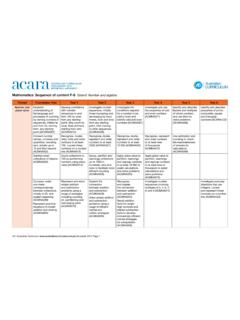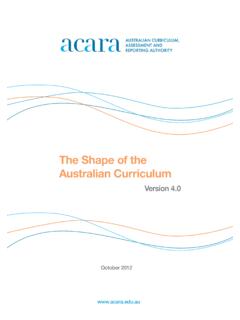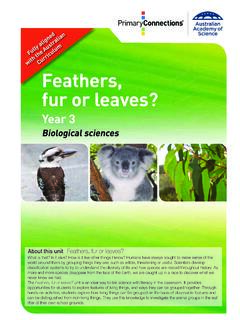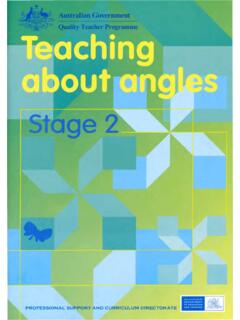Transcription of General Mathematics 2019 v1 - Queensland Curriculum and ...
1 General Mathematics 2019 General Senior Syllabus This syllabus is for implementation with Year 11 students in 2019. 170088 Contents 1 Course overview _____ 1 Introduction .. 1 Rationale .. 1 Learning area structure .. 3 Course structure .. 4 Teaching and learning .. 5 Syllabus objectives .. 5 Underpinning factors .. 6 Aboriginal perspectives and Torres Strait Islander perspectives .. 10 Pedagogical and conceptual frameworks .. 10 Subject matter .. 15 Assessment General information .. 16 Formative assessments Units 1 and 2 .. 16 Summative assessments Units 3 and 4 .. 16 Reporting standards .. 17 2 Unit 1: Money, measurement and relations _____ 19 Unit description.
2 19 Unit objectives .. 19 Topic 1: Consumer arithmetic .. 20 Topic 2: Shape and 20 Topic 3: Linear equations and their graphs .. 21 Assessment guidance .. 21 3 Unit 2: Applied trigonometry, algebra, matrices and univariate data _____ 22 Unit description .. 22 Unit objectives .. 22 Topic 1: Applications of trigonometry .. 23 Topic 2: Algebra and matrices .. 23 Topic 3: Univariate data analysis .. 24 Assessment guidance .. 24 4 Unit 3: Bivariate data, sequences and change, and Earth geometry _____ 25 Unit description .. 25 Unit objectives .. 25 Topic 1: Bivariate data analysis .. 26 Topic 2: Time series analysis .. 27 Topic 3: Growth and decay in sequences.
3 27 Topic 4: Earth geometry and time zones .. 28 Assessment .. 29 Summative internal assessment 1 (IA1): Problem-solving and modelling task (20%) .. 29 Summative internal assessment 2 (IA2): Examination (15%) .. 33 Summative external assessment (EA): Examination (50%) .. 37 5 Unit 4: Investing and networking _____ 38 Unit description .. 38 Unit objectives .. 38 Topic 1: Loans, investments and annuities .. 39 Topic 2: Graphs and networks .. 39 Topic 3: Networks and decision Mathematics .. 40 Assessment .. 41 Summative internal assessment 3 (IA3): Examination (15%) .. 41 Summative external assessment (EA): Examination (50%) .. 45 6 Glossary _____ 48 7 References _____ 76 8 Version history _____ 78 General Mathematics 2019 General Senior Syllabus Queensland Curriculum & Assessment Authority July 2018 Page 1 of 78 1 Course overview Introduction Rationale Mathematics is a unique and powerful intellectual discipline that is used to investigate patterns, order, generality and uncertainty.
4 It is a way of thinking in which problems are explored and solved through observation, reflection and logical reasoning. It uses a concise system of communication, with written, symbolic, spoken and visual components. Mathematics is creative, requires initiative and promotes curiosity in an increasingly complex and data-driven world. It is the foundation of all quantitative disciplines. To prepare students with the knowledge, skills and confidence to participate effectively in the community and the economy requires the development of skills that reflect the demands of the 21st century. Students undertaking Mathematics will develop their critical and creative thinking, oral and written communication, information & communication technologies (ICT) capability, ability to collaborate, and sense of personal and social responsibility ultimately becoming lifelong learners who demonstrate initiative when facing a challenge.
5 The use of technology to make connections between mathematical theory, practice and application has a positive effect on the development of conceptual understanding and student disposition towards Mathematics . Mathematics teaching and learning practices range from practising essential mathematical routines to develop procedural fluency, through to investigating scenarios, modelling the real world, solving problems and explaining reasoning. When students achieve procedural fluency, they carry out procedures flexibly, accurately and efficiently. When factual knowledge and concepts come to mind readily, students are able to make more complex use of knowledge to successfully formulate, represent and solve mathematical problems.
6 Problem-solving helps to develop an ability to transfer mathematical skills and ideas between different contexts. This assists students to make connections between related concepts and adapt what they already know to new and unfamiliar situations. With appropriate effort and experience, through discussion, collaboration and reflection of ideas, students should develop confidence and experience success in their use of Mathematics . The major domains of Mathematics in General Mathematics are Number and algebra, Measurement and geometry, Statistics and Networks and matrices, building on the content of the P 10 Australian Curriculum . Learning reinforces prior knowledge and further develops key mathematical ideas, including rates and percentages, concepts from financial Mathematics , linear and non-linear expressions, sequences, the use of matrices and networks to model and solve authentic problems, the use of trigonometry to find solutions to practical problems, and the exploration of real-world phenomena in statistics.
7 General Mathematics is designed for students who want to extend their mathematical skills beyond Year 10 but whose future studies or employment pathways do not require calculus. It incorporates a practical approach that equips learners for their needs as future citizens. Students will learn to ask appropriate questions, map out pathways, reason about complex solutions, set up models and communicate in different forms. They will experience the relevance of Mathematics to their daily lives, communities and cultural backgrounds. They will develop the ability to understand, analyse and take action regarding social issues in their world. When students gain skill and self-assurance, when they understand the content and when they evaluate their success by using and transferring their knowledge, they develop a mathematical mindset.
8 General Mathematics 2019 General Senior Syllabus Queensland Curriculum & Assessment Authority July 2018 Page 2 of 78 Assumed knowledge, prior learning or experience Assumed knowledge refers to the subject matter that teachers can expect students to know prior to beginning each unit. Emphasis is placed on the mastery of content, ensuring key concepts or procedures are learnt fully so they will not need reteaching. Developing mastery often involves multiple approaches to teaching and conceptualising the same mathematical concept. When students have a good understanding of a key concept or procedure, they are more easily able to make connections to related new subject matter and apply what they already know to new problems.
9 Subject matter from previous unit/s is assumed for subsequent unit/s. The following is a non-exhaustive list of assumed knowledge from the P 10 Australian Curriculum that must be learnt or revised and maintained as required: solve a range of problems using percentages, rates and ratios, surface area and volume, Pythagoras theorem, simple algebraic fractions, linear and quadratic equations understand the connection between algebraic and graphical representations, using appropriate technology when necessary calculate and compare measures of central tendency (mean, median and mode) and measures of spread; determine quartiles, interquartile range (IQR) and range construct and interpret box plots and use them to compare datasets.
10 Compare shapes of box plots to corresponding histograms and dot plots use scatter plots to investigate and comment on relationships between two numerical variables understand bivariate numerical data where the independent variable is time solve right-angled triangle problems, using trigonometric ratios solve simultaneous equations construct back-to-back stem-and-leaf plots and histograms solve linear equations understand the difference between numerical and categorical variables solve basic problems involving simple and compound interest. Pathways General Mathematics is a General subject suited to students who are interested in pathways beyond school that lead to tertiary studies, vocational education or work.

